Perhaps you’re wondering: What is acroyoga?
This post will teach you what it is and what acroyoga will teach you.
I started practicing acroyoga 3 years ago, teaching acroyoga 1 year ago and since then I have grown in so many ways.
What is acroyoga?
Acroyoga is a fusion of yoga and acrobatics. Acroyoga takes elements from yoga such as presence, groundedness, breath, and mindfulness and mixes it with elements from acrobatics such as technique and athleticism.
Acroyoga is a partner activity where you share your practice with others. Prepare to play, fall and move together – creating trust and connection along the way.
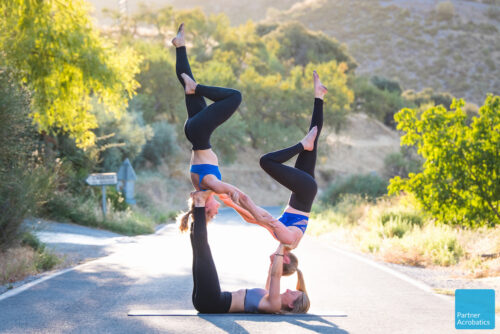
The roles of acroyoga
There are 3 roles in acroyoga; base, flyer, and spotter.
Base
The base – this is the person who is closest to the ground. Often times in acroyoga it is the person who is lying with on her/his back on the ground and the legs and arms extended into the air. The base can also be standing (standing acro) or lying on the belly (belly basing). The main goal of the base is to carry and balance the flyer on top of her/him. An experienced base is strong, stable, and flexible so they can remain a solid foundation for the flyer to stay on.

Flyer
The flyer – this is the person who is flying on top of another person in one way or another. The flyer has one or more points of contact with the base and use these to stay lifted off the ground and to stay balanced on top of the base. The main goal of the flyer is to move with spacial awareness and hold good body tension so the base can control their position in the air. An experienced flyer is strong and has good body awareness and balance so they can move efficiently, fluidly and hold a stable shape for the base to support and lift.
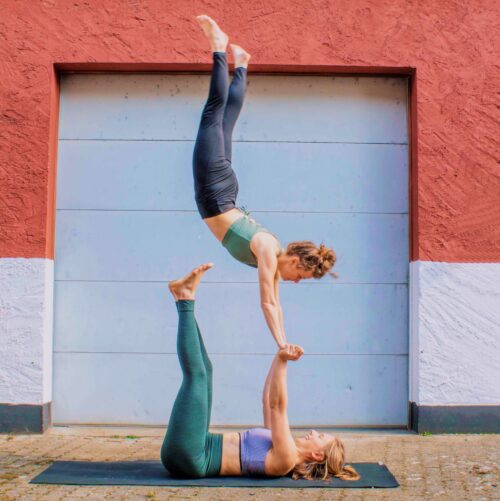
Spotter
The spotter – this is the person that makes sure the acroyoga practice stays safe. The spotter’s main goal is to keep the flyer safe. They do so by staying alert and close to the flyer at all times so they can catch a potential fall or support the flyer and base with hands-on spotting in the trick until the base and flyer feel safe enough to perform the trick with a less involved spotting method.
Tired of dealing with aching wrists in your practice?
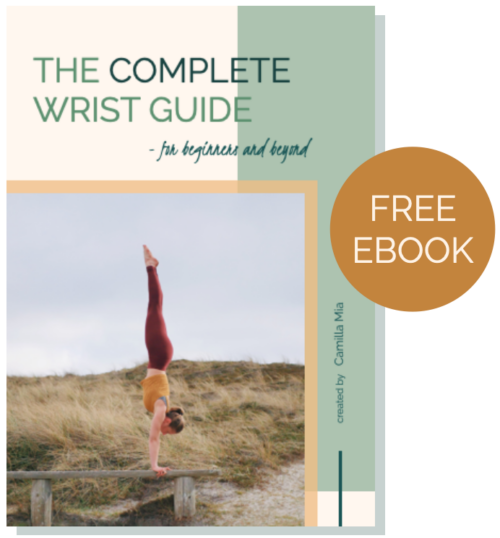
Get The Complete Wrist Guide so you can practice yoga, arm balances, and handstands with ease and stability!
The ebook includes 17 exercises that build strength and flexibility in your wrists and forearms, two exercise program templates, and a printable wrist exercise sheet, along with tips on how to position your hands and distribute weight in your palms for optimal comfort and balance.
What does acroyoga have to do with yoga?
When watching people perform an acroyoga flow it can sometimes be hard to figure out where the yoga aspect comes in.
What makes acroyoga so different from classical acrobatics or circus arts is that there is a much bigger emphasis on the how – the process of the practice together and the connection between the base and the flyer. These values are highlighted in acroyoga preserving the mindful aspects of yoga in the practice.
In circus and acrobatic arts, the emphasis is mainly on the what – the outcome, the aesthetics and the technique of the trick. These values being highlighted more giving these movement styles a larger focus on athleticism and performance.
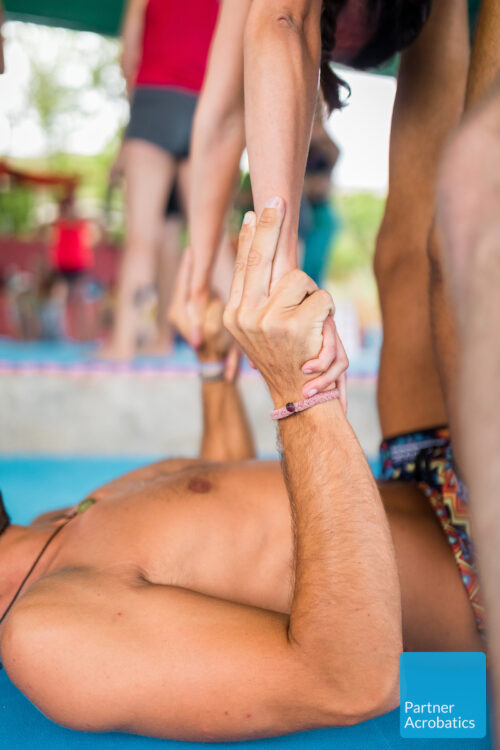
Technical principles of acroyoga
There are two main technical principles to learn when you’re first getting into acroyoga; bone-stacking and counterbalancing.
Bone-stacking
Bone-stacking means that the base and flyers limbs are stacked directly on top of each other to create the most stable and efficient foundation as possible in each position. When an acroyoga pose is perfectly bone-stacked it requires a lot less strength to stay in the pose.
Counterbalancing
Counterbalancing is when the trick is no longer bone-stacked but base and flyer finding stability by leaning away from each other. Counterbalance is achieved when the pull of one person’s weight is balanced out by the pull of the other person’s weight in the opposite direction.
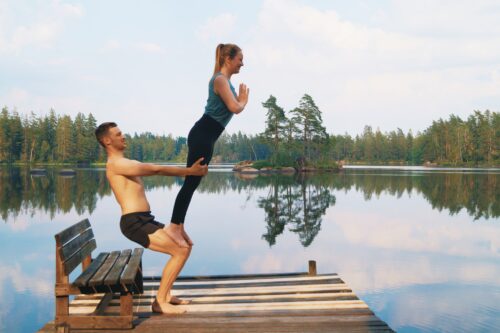
Cooperation, communication, and trust
Compared to yoga, acroyoga requires much more cooperation, communication, and trust since it takes two or more people to perform an acroyoga pose or flow. The practice of acroyoga will expand your comfort zone and challenge you to face many of your emotions honestly and kindly.
The process of learning acroyoga requires open communication in order to work well. All three roles; base, flyer, and spotter need to openly share what they need in order to feel safe and get the trick to work.

Since each person in a group has a unique role in the acroyoga trick, they have to communicate their perspective on the trick for every part to get a fuller understanding of the trick as a whole. Therefore, it can also be a great idea to switch roles every once in a while, so all three roles have a better sense of what it takes to accomplish the trick.
Acroyoga also teaches you to hand over trust to other people. Most acroyoga tricks don’t work unless the flyer really commits to the trick and trusts that the base and spotter will support them until they have safely returned to the ground.
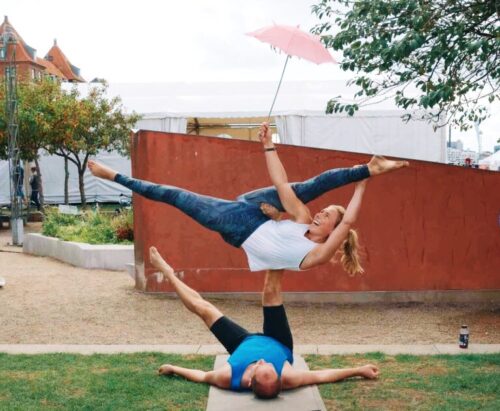
Strength, flexibility, balance, and body awareness
Aside from the inter-personal and emotional benefits of acroyoga there are many physical challenges to overcome as well. Acroyoga will help you build strength, flexibility, and balance. The practice will also fine-tune your body awareness since you’re no longer only moving on your own, but moving with another person.
Solar and lunar acroyoga
Solar / acrobatic acroyoga – explores and challenges our strength and flexibility in different poses and flows.
Lunar / restorative acroyoga – nurtures, calms, and restores the body through thai yoga massage and flying therapeutics techniques.
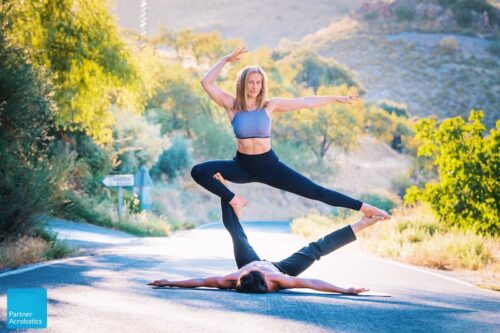
Is acroyoga for you?
Acroyoga is for you if you want to develop strength, flexibility, coordination, balance, body awareness BUT you also become better at cooperating, physical touch, communicating and openly saying yes and no, and rediscover how to play, feel connected in an inclusive community, face your fears and other emotions in an honest and loving way. All the while you’re having lots and lots of FUN.
Do you think acroyoga is for you? Leave a comment down below!
As always, I’m rooting for you!
xox Cami

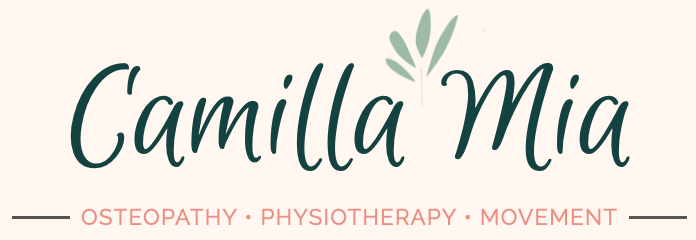
I want a try acroyoga is it possible to drop in just to see is this for me?
It’s usually okay for drop-in classes but not late in the season for the classes that spand over multiple months since the level and pace will be assuming that you were present the entire season. Hope that makes sense!
Write me on email, facebook or instagram if you feel like joining a specific class and I’ll let you know whether it’s open for newcomers or not 🙂